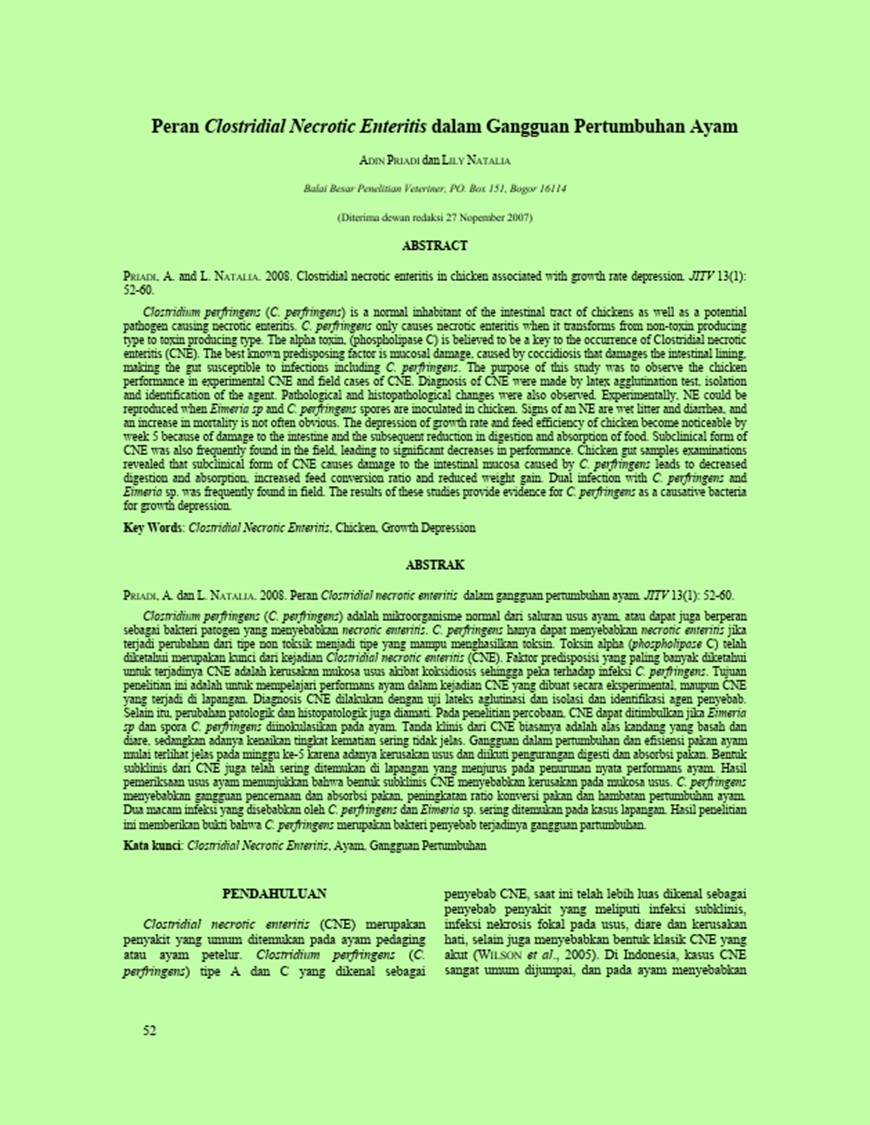
| Judul | Peran Clostridial Necrotic Enteritis dalam Gangguan Pertumbuhan Ayam / ADIN PRIADI |
| Pengarang | ADIN PRIADI LILY NATALIA |
| EDISI | Vol. 13 No. 1 |
| Penerbitan | Balai Besar Penelitian Veteriner : JITV, 2008 |
| Deskripsi Fisik | 9 |
| Subjek | Clostridial Necrotic Enteritis |
| Abstrak | Clostridium perfringens (C. perfringens) is a normal inhabitant of the intestinal tract of chickens as well as a potential pathogen causing necrotic enteritis. C. perfringens only causes necrotic enteritis when it transforms from non-toxin producing type to toxin producing type. The alpha toxin, (phospholipase C) is believed to be a key to the occurrence of Clostridial necrotic enteritis (CNE). The best known predisposing factor is mucosal damage, caused by coccidiosis that damages the intestinal lining, making the gut susceptible to infections including C. perfringens. The purpose of this study was to observe the chicken performance in experimental CNE and field cases of CNE. Diagnosis of CNE were made by latex agglutination test, isolation and identification of the agent. Pathological and histopathological changes were also observed. Experimentally, NE could be reproduced when Eimeria sp and C. perfringens spores are inoculated in chicken. Signs of an NE are wet litter and diarrhea, and an i |
| Bentuk Karya | Tidak ada kode yang sesuai |
| Target Pembaca | Tidak ada kode yang sesuai |
| No Barcode | No. Panggil | Akses | Lokasi | Ketersediaan |
|---|---|---|---|---|
| ARTVET1397 | ARTVET1397 | Dapat dipinjam | Perpustakaan Balai Besar Perakitan dan Modernisasi Veteriner - Ruang Baca Umum | Tersedia |
| Tag | Ind1 | Ind2 | Isi |
| 001 | INLIS000000000019060 | ||
| 005 | 20250203083634 | ||
| 007 | ta | ||
| 008 | 250203################|##########|#|## | ||
| 035 | # | # | $a 0010-0924000139 |
| 082 | # | # | $a ARTVET1397 |
| 084 | # | # | $a ARTVET1397 |
| 100 | 0 | # | $a ADIN PRIADI |
| 245 | 1 | # | $a Peran Clostridial Necrotic Enteritis dalam Gangguan Pertumbuhan Ayam /$c ADIN PRIADI |
| 250 | # | # | $a Vol. 13 No. 1 |
| 260 | # | # | $a Balai Besar Penelitian Veteriner :$b JITV,$c 2008 |
| 300 | # | # | $a 9 |
| 520 | # | # | $a Clostridium perfringens (C. perfringens) is a normal inhabitant of the intestinal tract of chickens as well as a potential pathogen causing necrotic enteritis. C. perfringens only causes necrotic enteritis when it transforms from non-toxin producing type to toxin producing type. The alpha toxin, (phospholipase C) is believed to be a key to the occurrence of Clostridial necrotic enteritis (CNE). The best known predisposing factor is mucosal damage, caused by coccidiosis that damages the intestinal lining, making the gut susceptible to infections including C. perfringens. The purpose of this study was to observe the chicken performance in experimental CNE and field cases of CNE. Diagnosis of CNE were made by latex agglutination test, isolation and identification of the agent. Pathological and histopathological changes were also observed. Experimentally, NE could be reproduced when Eimeria sp and C. perfringens spores are inoculated in chicken. Signs of an NE are wet litter and diarrhea, and an increase in mortality is not often obvious. The depression of growth rate and feed efficiency of chicken become noticeable by week 5 because of damage to the intestine and the subsequent reduction in digestion and absorption of food. Subclinical form of CNE was also frequently found in the field, leading to significant decreases in performance. Chicken gut samples examinations revealed that subclinical form of CNE causes damage to the intestinal mucosa caused by C. perfringens leads to decreased digestion and absorption, increased feed conversion ratio and reduced weight gain. Dual infection with C. perfringens and Eimeria sp. was frequently found in field. The results of these studies provide evidence for C. perfringens as a causative bacteria for growth depression. |
| 650 | # | 4 | $a Clostridial Necrotic Enteritis |
| 700 | 0 | # | $a LILY NATALIA |
| 990 | # | # | $a ARTVET1397 |
| No | Nama File | Nama File Format Flash | Format File | Action |
| 1 | 1361.pdf | ARTVET1361 | Baca Online |
Content Unduh katalog
Karya Terkait :